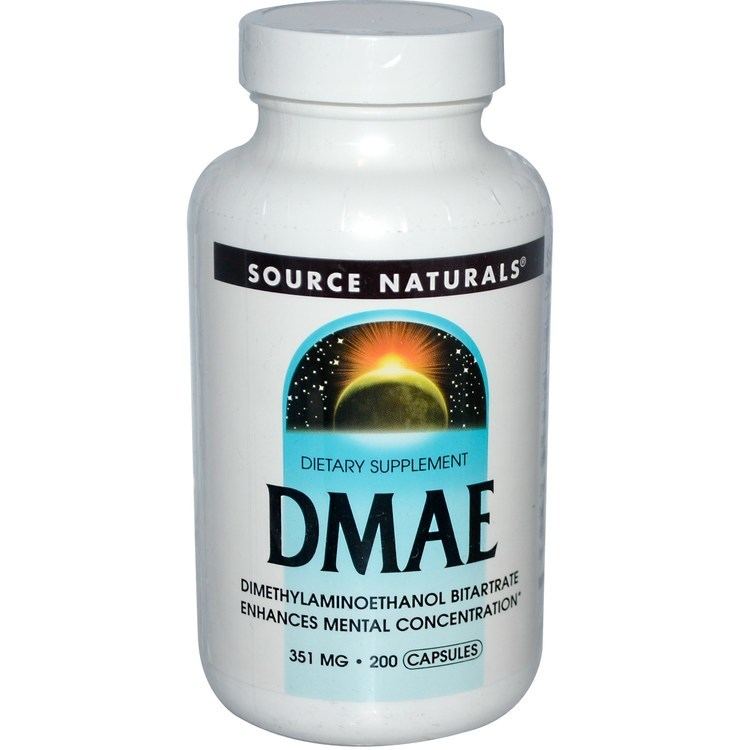Abbreviations DMAE, DMEA Related compounds Molar mass 89.14 g/mol Boiling point 133 °C Melting point -70 °C | Appearance Colourless liquid Formula C4H11NO Density 890 kg/m³ IUPAC ID 2-(Dimethylamino)ethanol | |
 | ||
Related alkanols | ||
Dimethylaminoethanol and dimethylethanolamine (DMAE and DMEA respectively), with deanol, are common names for 2-(dimethylamino)ethanol.
Contents
Chemical structure and properties
This compound has tertiary amine and primary alcohol groups as functional groups. The alcohol functionality, in combination with the amine and its low molecular weight imparts water solubility on the compound, and makes ester derivatives possible; the amine functionality gives the compound its alkaline character, and allows for formulation of salts of the compound.
Safety and Toxicity
Although preliminary, it seems that DMAE may aggravate or induce the formation of neural tube defects, as evidenced by in vitro studies on mouse embryonic cells. Under normal conditions, rat embryos uptake choline and convert it into phosphatidylcholine(PC) as an active substrate. DMAE supplementation seems to replace choline usage when it is present due to higher affinity and competition but fails to convert into PC due to an apparent lack of expression of the enzyme phosphatidylethanolamine methyltransferase (PeMT) in embryos. This enzyme is absolutely necessary for the conversion of Phosphatidylethanolamine into PC.
Essentially, DMAE competitively inhibits Choline uptake during the first few days of neural tube formation (1–10 days after impregnation), but the embryo is not yet able to use DMAE as well as an adult due to an immature CDP-choline metabolic pathway and underexpression of key enzymes.
These mechanisms should not occur in adult cells due to the activity of the PeMT enzyme and a mature CDP-choline metabolic enzyme pathway.
Uses
Its characteristics arise from its chemical features as well as from its overall structural similarity to chemical compounds involved in primary metabolism and neurophysiology.
Biochemical roles
According to WebMD:
"Deanol is a chemical that is involved in a series of reactions that form acetylcholine, a chemical that is found in the brain and other areas of the body. Acetylcholine is a "neurotransmitter" that helps nerve cells communicate.
Deanol is used for treating attention deficit-hyperactivity disorder (ADHD), Alzheimer's disease, autism, and a movement disorder called tardive dyskinesia. It is also used for improving memory and mood; boosting thinking skills and intelligence; and increasing physical energy, oxygen efficiency, athletic performance, and muscle reflexes. It is also used for preventing aging or liver spots, improving red blood cell function, and extending life span.
Deanol is applied to the skin for reducing signs of aging, particularly loose or sagging skin.
Deanol was previously sold by Riker Laboratories as the prescription drug Deaner. It was prescribed for the management of children with behavior problems and learning difficulties. Deanol is not an approved food additive in the U.S., nor is it an orphan drug, as some advertising suggests. Dimethylaminoethanol serves as a precursor of choline in the liver. In the brain, DMAE is incorporated into phospholipids, as phosphatidyldimethylethanolamine (PDME), which can then be converted, via N-methylation, to phosphatidylcholine. As a component of nerve membranes, PDME may increase fluidity and permeability, and acting as an antioxidant.
Topical Use
DMAE, in the form of facial cream, is being looked at for improving skin quality for aging skin when applied as a 3% facial cream. It shows benefits in improving the appearance of coarse wrinkles, under-eye dark circles, nasolabial folds, sagging neck skin, and neck firmness and is generally very well tolerated.
Most notably, DMAE as a facial gel increases skin firmness.
Rheology
DMAE (0.6% in vitro) appears to protect from iron-induced oxidation and subsequent protein cross-linking, thought to preserve membrane fluidity via anti-oxidative effects, either directly or by preventing formation of Nitroxyl radicals (hydroxyl radical binding with hydroxyproline) by non-oxidatively sequestering hydroxyl radicals.
Alzheimer's Disease
V0191 (DMAE Pyroglutamate) in 55-90 year old persons (mean age 72.2) with mild cognitive impairment taking 1500mg of the supplement daily at breakfast over 24 weeks noted that although there was a trend to more response with treatment than placebo (defined as more than a 4 point improvement on the ADAS-cog rating scale), there were no statistically significant improvements nor improvement on global assessments.
Tardive Dyskinesia
DMAE supplementation has been shown in some studies to show a small, albeit nonsignificant, positive trend for symptoms in tardive dyskinesia , but typically it is seen as an ineffective treatment.
Industrial uses
Industrial uses include as a bulk chemical in water purification, as a fine chemical precursor in pharmaceutical and other organic syntheses, and as an additive in a variety of applications, including with resins and coatings. There is expanding interest in use of DMAE as a nutraceutical, and it is has been tested as a possible therapeutic agent related to a variety of cholinergic functions.
DMAE is used in bulk quantities for water treatment, in the coatings industry, and as a curing agent for polyurethanes and epoxy resins. It is also used in the chemical synthesis of dyestuffs, pharmaceuticals, emulsifiers, textile auxiliaries, as an additive to paint removers and amino resins, and as an additive to boiler water to provide corrosion resistance. For instance, 2-dimethylaminoethyl chloride hydrochloride is synthesized from dimethylaminoethanol, and serves as an intermediate that is widely used for the manufacture of pharmaceuticals.
DMAE forms a number of salts with melting points below room temperature ionic liquids, (e.g. N,N-dimethylethanolammonium acetate and N,N-dimethylethanolammonium octanoate), which can be used in applications where alternatives to conventional solvents are required.
Neutraceutical uses
The bitartrate salt of DMAE, i.e. 2-dimethylaminoethanol (+)-bitartrate, is sold as a dietary supplement. It is a white powder providing 37% DMAE.
